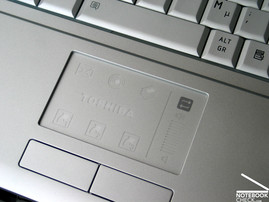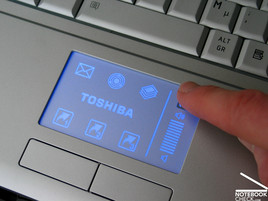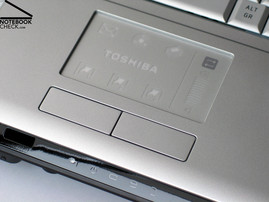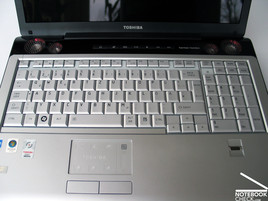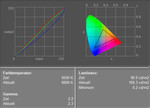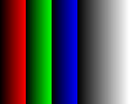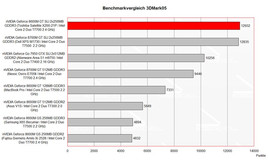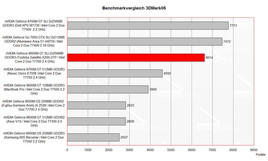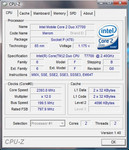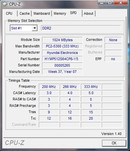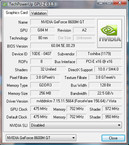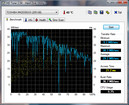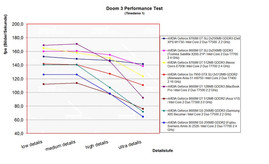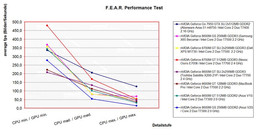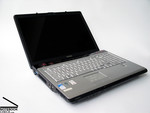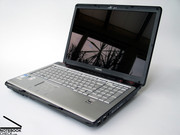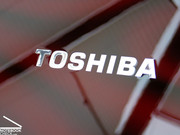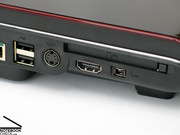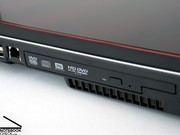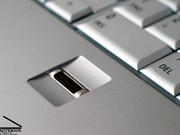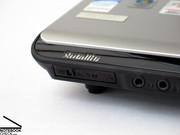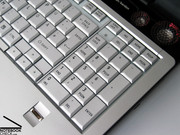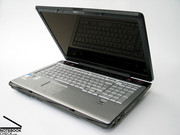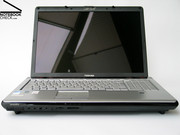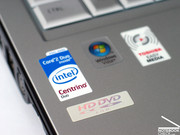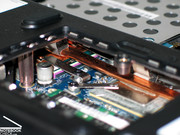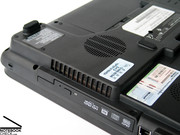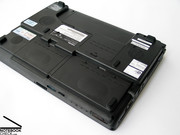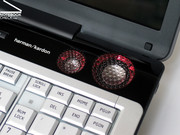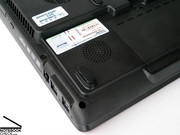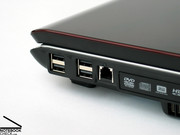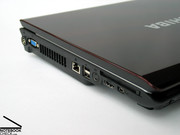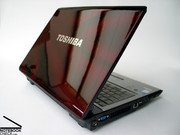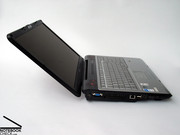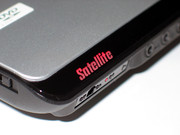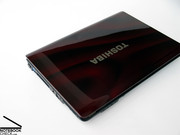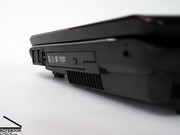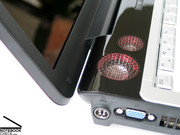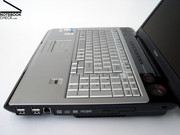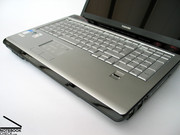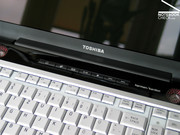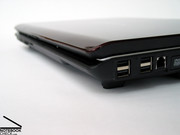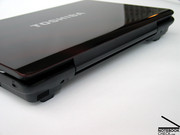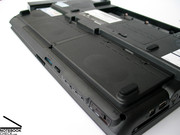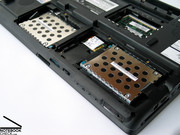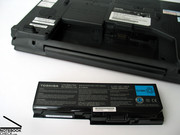Review Toshiba Satellite X200-21P gaming notebook
Satego copy.
Beside the Satego X200 gaming series, Toshiba also offers the Satellite X200 series, which does not differ to much from the former at the first glance. There is first-class hardware in a striking case, so, also the Satellite X200 is indeed a gaming notebook. Powerful Intel Core 2 Duo processors and a powerful video cards, like Geforce 8700m GT or 8600m GT SLI, which the reviewed notebook came with, grant excellent gaming performance.
Case
The case of the Toshiba Satellite X200 is nearly identical to the one of the Satego X200. There is only one difference, a red illuminated Satellite logo at the left side of the front edge. The lid is again marbled red black finished. And left and right above the keyboard Harman/Cardon speakers can also be found again.
In contrary to competitor notebooks, like the Dell XPS M 1730 or the Asus G2, which make intensively use of LED effects, the look of the Satellite X200 is far more decent. Although the indicator LEDs at the front edge and the illuminated "Satellite" nameplate shine rather bright, the total appearance of the case is still relatively decent.
According to the color and form choice, it's easy to tell that the X200 is indeed a Toshiba notebook. The edges are beveled. The case is structured in two parts, whereas the bottom part was slightly moved to the inside. So, the case, which has a total height of 47mm, appears a little slimmer than it actually is. In order to improve ergonomics, the base unit is slightly inclined, which contributes to typing comfort.
The stability of the case is excellent. Though it weighs 4070 grams you can handle this notebook without creaking noises or deformations. In this aspect the two hard disk covers at the bottom side of the base unit ought to be mentioned too. Known as "HDD-Dome", a slight bulge of the cover allows to distribute applied forces to the sides and, so, ideally protect the hard disks underneath.
The 17 inches WSXGA display is attached via one big central hinge. The way its constructed allows a maximum opening angle of 140°. When adjusting the display's position, we could observe a slight possible see-saw.
Interfaces
The Satellite X200 is identically equipped with interfaces than the Satego X200. The back side is free of ports, because of the opening mechanism of the display. The ports are mainly located at the flanks, most of them on the left side. Among others, there are a VGA port, a S-Video out, and a HDMI port for digital audio and video out.
Besides two USB 2.0 ports on the left side, there are also four USB 2.0 ports on the right side. However, they are rather near the front, which is unreasonable for right-handers, because cable spaghetti might limited the area of operation of the right hand. Furthermore, there are vent holes at the right and the left side, which blow warm air to the mouse hand, especially under high load, e.g., when playing games. When the distance to the vent hole was too small, it turned actually nasty.
At the front edge there are four audio ports, which are Line-In, S/PDIF, microphone, and headphone. This is alright for connecting a headset, however, not ideal for permanently attaching sound hardware.
A webcam with a resolution of 1.3 megapixel is provided in the display frame. It can be used by means of the pre-installed "camera assistant software". Furthermore, the Toshiba Satellite X 200-21P comes with a HD DVD drive, which allows to play HD contents and DVDs.
Input Devices
The Toshiba Satellite X200's keyboard is clearly structured. The size of its keys is big. Furthermore, it provides an extra numerical keypad right beside the standard keyboard. Whilst some keyboard layouts require that some keys are smaller than standard size, the keys of Satellite X200's keyboard have standard size and there was even space left for a gap between standard keyboard and numerical keypad.
The silver keys have a roughened surface, which feels interesting to the touch. Typing felt a little bumpy, first of all, because of the early feedback, but, also because of the low low lateral support of the pushed down key. The noise varies depending on your typing habits from silently clicking to a little clattering.
The touch pad is centered relative to the standard keyboard, in front of the keyboard. It's surface is user-friendly, and there is an optically highlighted scroll region. However, scrolling works only at the outer edge of the marked scroll region.
Touching the symbol at the right upper corner, will bluely illuminate the pad, so, that other symbols, imprinted on the pad, will get visible. Touching those gadgets allows to launch different action, like e-mail, Connectivity Doctor, Windows picture gallery, ... Furthermore, you can adjust the volume by striking the scroll region in this mode.
Furthermore, the Satellite X200 provides the standard way of pressing an FN + key combination, for changing various settings. However, Toshiba also provides a pre-installed software tool, a minimized menu at the upper display edge, which opens upon pressing FN and allows to configure the notebook by mouse click.
Above the keyboard there is string of hot-keys which allows to control the Mediaplayer. Furthermore, the X200 comes with a fingerprint reader, which can easy access control. At the front edge, there is a switch for controlling the WLAN and the typical Toshiba dial volume control.
Display
All Satellite X200 models come nowadays with a 17 inch WSXGA display with TruBrite surface and a resolution of 1680x1050 pixels. Regarding desktop size and fineness you are clearly better of with this screen than with a WXGA+ screen. If you'd like to play computer games with the display's native resolution, you'll also require a top hardware equipment. Otherwise, you'll likely need to reduce the resolution for better performance.
The maximum brightness was 173 cd/m², measured in the center of the display. However, the brightness diminishes at the edges, especially in the upper right area, where we measured the minimum brightness of 106 cd/m². To summarize it, the average luminance of 138.7 cd/m ² is rather moderate.
| |||||||||||||||||||||||||
Brightness Distribution: 67 %
Contrast: 729:1 (Black: 0.23 cd/m²)
The brightness in the corners is significantly lower, so, that there is a difference of 38%. Depending on the brightness of the displayed pictures, this is not recognizable or you'll recognize slightly darker corners. The good thing is that the display is driven with full brightness even in battery mode.
The Satellite X200's screen scores points regarding contrast. A quite low black value of only 0.23 cd/m ² gives together with the maximum brightness an excellent contrast ratio of 752:1.
The reaction speed of the display is 18ms (gray to gray response time, averaged standardized 8 point measurement). Though not absolutely convincing, this should be sufficient for hobby gamers.
As you can see on the video about the viewing angles, the reflecting surface is the major drawback of the provided display. Even indoors in moderately bright environments you can face reflections when displaying dark pictures. So, we recommend to carefully place the notebook with regard to surrounding sources of light. For the same reason you can forget about using this notebook outdoors.
Regarding viewing angles, you'll face a slow loss of contrast and reflections horizontally. Vertically, when looking from bottom up, the display darkens while it whitens, when looking the other way round. The area of operation is acceptable and sufficient.
Video of Display's Viewing Angles
Performance
The Toshiba Satellite X200 is offered with three different processors out of the house Intel (T7300, T7500 and T7700) as well as with two different graphics cards currently. A nVIDIA Geforce 8600mGT SLI solution and a Geforce 8700 M GT graphics card can be chosen regarding this.
The question which of the two options the roper Gaming performance promises now arises here. One may more efficient 8700M GT graphics card with 256 of this one to himself or 512 MB of GDDR3 video memory and one hope for assembly line balancing of 625/800 MHz of the roper results or make two 8600M GT chips (475/700 MHz and 2x256MB GDDR3 VRAM) in the SLI combine the run?
We look at the two variants in the comparison of the reached 3D marks benchmark results first. Here the 8600M GT get clear quite fast that this solution has the nose considerably in front. With 3D Mark 2006 benchmark the two Geforce 8600M GT graphics cards in the SLI combine only just behind the Geforce Go 7950 GTX SLI and the Geforce 8700 M GT SLI graphic solutions. According to first reports the Geforce still bothered by acute difficulties with supply of 8800 M GTX shall be the 3D Mark06 benchmark comparison considerably first with about 9000 points.
At the time of writing the Satellite X200 is available with three different Intel CPUs, (T7300, T7500, or T7700). Furthermore, you can choose between two different video cards, the Geforce 8700M GT SLI video card or a 8600M GT SLI video card.
Obviously, the most important question is which of these provides the better gaming performance. Is it the inherently more powerful 8700M GT or two 8600M GT video cards in SLI network?
Let's first look at the 3DMark results of these two versions. Here the 8600M GT SLI bundle clearly wins. The 3DMark 2006 uncovers that the two 8600GT SLI cards are slightly outperformed by the Geforce Go 7950 GTX SLI and the Geforce 8700M GT SLI solution. First reports state that the Geforce 8800M GTX, which has supply difficulties at the moment, reaches 9000 points in the 3DMark06 benchmark, which is clearly top.
As these benchmark results do not necessarily inform about gaming performance in practice, we performed some gaming test. The following diagrams depict the results of Doom3 (OpenGL) and F.E.A.R (DirectX 9). Of course you'll also need to consider other equipment details, e.g., CPU performance, if you compare the results, because they have quite a big impact when running these games at low resolution and details. The graphic performance gets more obvious, if you run these games at high resolution and details.
The Doom 3 performance test (Timedemo 1, average frames/second) with ultra details and a standard resolution of 1024x768 is won by the 8700M GT SLI video solution, followed by the 8600M GT SLI chip, followed (with some distance) by the 8700M GT video card, the Geforce Go 7950 GTX SLI, and the 8600M GT.
However, the results of FEAR, which is rather demanding and sensible to driver troubles, is completely different. The7950 GTX SLI wins, followed by the rest of the examined video cards, which are close to each other. We were especially surprised by the good results of the 8600M GS video card with GDDR memory in the Samsung X65, which reached excellent 68 fps at maximum CPU and GPU settings. This also hints on a general driver problem with FEAR.
Looking into the future, DirectX 10 gets important. Although, there is no notebook available at the moment, which would provide smooth DirectX10 gaming fun at a good resolution, this is a main aspect for high-performance video chips, such as in the Toshiba X200, nowadays.
The Crysis CPU and GPU benchmark results were rather disillusioning. The Satellite reached at a resolution of 1024x768 and presets at low 55.6 Fps in the GPU and 54.4 Fps in this CPU test on average. If you either increase the resolution or the number of details, the game gets unplayable. Furthermore, the benchmark test was again and again interrupted and the error message " CryEngine2 does no longer work" was displayed, when we tried medium details at a resolution of 1280x800.
So, regarding Crysis you'll still need to wait for the 8800M GTX video card, which will be provided in some notebooks at the beginning of 2008.
The strategy game World in Conflict also supports DirectX10 at high details. The results were similar to Crysis: Even at a low resolution of 800x600 pixels we measured only 18 fps in benchmark test. However, the results at medium details (DirectX9) were clearly better. 34 Fps at a resolution of 1280x800 are well playable. This is also proved by the following game test in practice.
During a 2 vs 2 game we measured an average of 70-90 Fps and the game ran smoothly. A higher resolution (1280x800) is also possible, however, there might be some flickering. However, setting details to high (DX10) causes a clear loss of performance. At resolutions from 1280x800 to 1680x1050 only 10-20 Fps were possible, which is far from being playable. For comparison, e.g., the mySN D901C DTR Notebook with 8700MGT SLI video card and Intel Core Extreme 3.0 GHz CPU reached 20-30 fps here.
Still, the question whether to prefer a Satellite X200 with 8600M GT SLI or Geforce of 8700M GT remains difficult to answer. If you stick to the 3DMark results the SLI video solution is better. In practice the SLI solution is also better at Doom3, however, outperformed by the 8700M GT at FEAR. Overall, the performance of these two solutions are close, but, the SLI solution can only run at highest performance, if SLI is supported by the software. So, the more powerful 8700M GT will outperform the two 8600M GTs, whenever a game does not support SLI.
Furthermore, we want to mention two further equipment details of the Satellite X200: The notebook computer is equipped with two hard disks, each having a capacity of 200 GB. So, a total hard disk capacity of 400 GB is available. Two Toshiba MK2035GSS hard disks with a revolution speed of 4200 revs/min are used. Compared to other 5400 and 7200 revs/min hard disk the transfer rate and access time of these two were clearly worse. If you don't need that much capacity and would prefer a better hard disk performance you might be better off by choosing 2 160GB 5400 revs/min hard disks, which are provided by other X200 models.
Furthermore, the X200-21P comes with an Intel turbo memory PCI express module ("Robson"), which provides quick access to files often accessed. However, it is still heavily discussed whether there is an actual performance gain.
Since these benchmark values do not give information absolutely also over the practical playing performance, of course playing tests are also inevitable. Followingly two diagrams with the comparison of current graphics cards with the Games Doom3 (opengl) and F.E.A.R. (DirectX9). Of course at these comparisons is the CPU performance and notebook computer also to take into account dependent differences which has very strongly partly a special effect at low resolutions and details. The graphic performance crystallizes more considerably only at high resolutions and detail wealth.
| 3DMark 2001SE Standard | 26684 points | |
| 3DMark 03 Standard | 21150 points | |
| 3DMark 05 Standard | 12932 points | |
| 3DMark 06 Standard Score | 6614 points | |
Help | ||
| PCMark 05 Standard | 5196 points | |
Help | ||
| Cinebench R10 | |||
| Settings | Value | ||
| Shading 32Bit | 3231 Points | ||
| Rendering Multiple CPUs 32Bit | 4606 Points | ||
| Rendering Single 32Bit | 2526 Points | ||
| Doom 3 | |||
| Resolution | Settings | Value | |
| 1024x768 | Ultra, 0xAA, 0xAF | 138.4 fps | |
| 800x600 | High, 0xAA, 0xAF | 154.9 fps | |
| 640x480 | Medium, 0xAA, 0xAF | 160.5 fps | |
| 640x480 | Low, 0xAA, 0xAF | 159.8 fps | |
| F.E.A.R. | |||
| Resolution | Settings | Value | |
| 1024x768 | GPU: max, CPU: max, 0xAA, 0xAF | 29 fps | |
| 800x600 | GPU medium, CPU medium, 0xAA, 0xAF | 30 fps | |
| 640x480 | GPU min, CPU min, 0xAA, 0xAF | 208 fps | |
Emissions
Loudness
Even in idle mode the fan ran permanently. Regardless, whether SLI was activated or deactivated, regardless of the Windows performance profile (balanced vs. energy saving) the fans ran always and caused a noise level of 37.5 dB.
However, the two built-in hard disks were rather quiet, and there noise level always stayed below the noise level of the fans.
Under load the fans start running at a higher speed, and reach a maximum noise level of 43.9dB. We observed that the speed of the fan changes from time to time under load.
Noise level
| Idle |
| 37.5 / 37.5 / 37.5 dB(A) |
| HDD |
| 37.5 dB(A) |
| DVD |
| 39.8 / dB(A) |
| Load |
| 41.9 / 43.9 dB(A) |
 | ||
30 dB silent 40 dB(A) audible 50 dB(A) loud |
||
min: | ||
Temperature
The two fans obviously well air the case. So, the surfaces don't get significantly warmer. A maximum of 30°C is hardly noticeably for the user.
Although, the bottom side gets clearly warmer, a maximum of 40°C is still alright.
(+) The maximum temperature on the upper side is 30.2 °C / 86 F, compared to the average of 40.5 °C / 105 F, ranging from 21.2 to 68.8 °C for the class Gaming.
(±) The bottom heats up to a maximum of 40.7 °C / 105 F, compared to the average of 43.3 °C / 110 F
(+) The palmrests and touchpad are cooler than skin temperature with a maximum of 24.8 °C / 76.6 F and are therefore cool to the touch.
(+) The average temperature of the palmrest area of similar devices was 28.9 °C / 84 F (+4.1 °C / 7.4 F).
Speakers
Quite a number of Toshiba notebooks are already equipped with Harman/Cardon speakers, and so is the Satellite X200-21P. The four speaker are nicely located above the keyboard. Each side has a speaker for high tones and another one for low tones. In addition there is a sub-woofer at the bottom side of the notebook.
We were pleased by the sound of this sound system, the sound is clear and bright. Also the basses are also alright. So, you can really enjoy listening to music or to sound effects when playing computer games.
Battery Runtime
The Thoshiba X200-21P is equipped with a 6000mAh (64.8 Wh) battery, which allows a limited mobile use of the notebook. Under load (Windows performance profile "High Performance", WLAN on, SLI activated, max.display brightness) we measured a battery runtime of less than one hour. The maximum runtime is about two hours (SLI deactivated, Windows performance profile "Battery saving", min. display brightness, WLAN off).
In practice, battery runtime won't be a primary aspect. Weighing about 4.1 kg it's better suited for desktop work anyway.
| Off / Standby | |
| Idle | |
| Load |
|
Key:
min: | |
Verdict
The Toshiba Satellite X 200-21 P is a well equipped DTR notebook computer, whose two Geforce 8600M GT video cards in SLI network could also attract gamers. The case looks good, yet decent. Furthermore, stability and workmanship of the case are good.
The X200 can basically score points by interface availability. Among others there are six USB 2.0 ports and a HDMI port. Furthermore, the notebook is equipped with a 1.3 megapixel webcam, a fingerprint reader, and a HD DVD drive. Depending on your needs the order of the interfaces might not be ideal.
The Satellite X 200-21P comes with a well structured keyboard, with good key size and an extra numerical keypad. Typing fast, the keys seemed a little loose and the keyboard clattered a little bit. The touch pad is user-friendly, whereas we liked its dual mode.
The WSXGA display in the 16:10 format provides a good desktop size and subjectively also a good picture. However, we detected a moderate luminance during our measurements. The glare type surface and the moderate brightness can lead to disturbing reflections.
Equipped with T7700 CPU by Intel and nVIDIA Geforce 8600M GT SLI video cards, the performance of the X200-21P is good. However, high resolutions and high details uncover limitations in games with DirectX10 support. Here only the Geforce 8800M GTX, which is not yet available at the moment, would be an alternative.
Unfortunately, high performance usually also means high waste heat. However, the two fans run permanently, so, the surface temperature stays always alright.
The sound output of the Harman/Cardon sound system is first-class.









